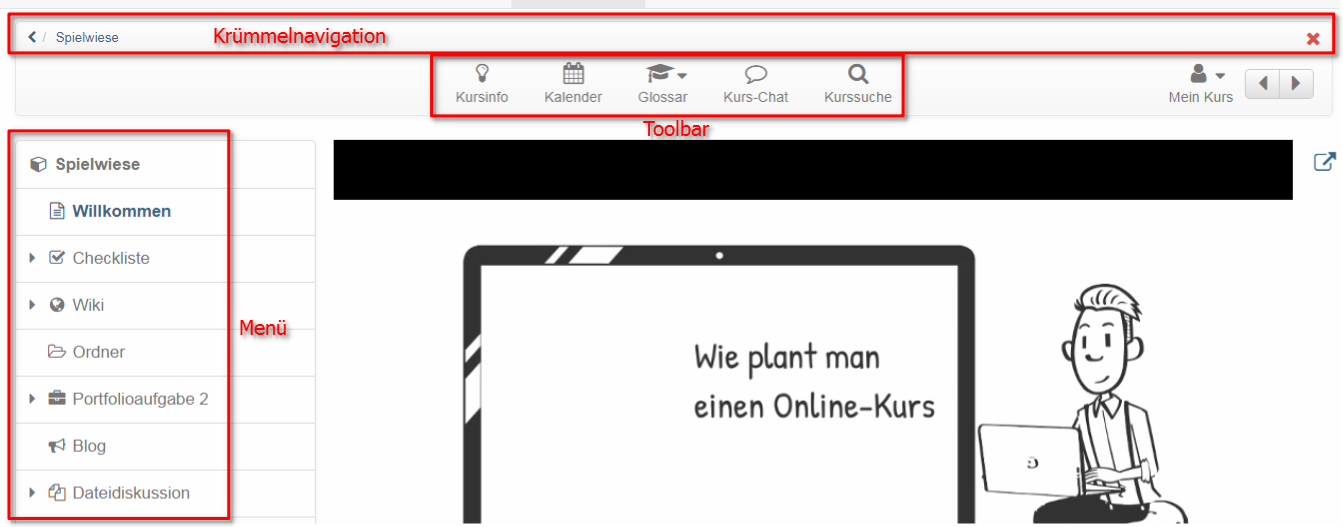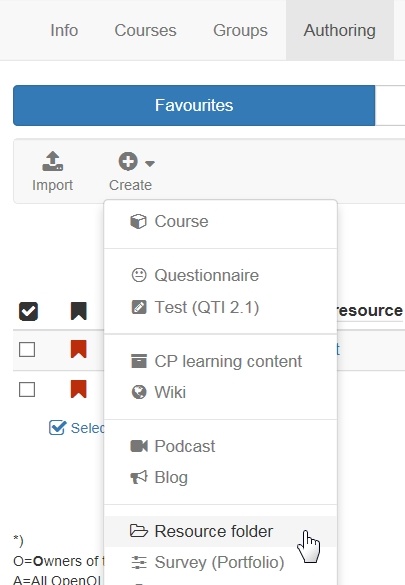In addition to the course editor and the course tools there are other features and settings at your disposal. For the course, the drop-down menu "Course" lists all of the functions following below.
Each learning resource, not just courses, have a menu "Settings".
Via the tabs "Info", "Metadata", "Execution" and "Share" you can set up information that is visible in the course info.
Info
Here you define further information on the course or learning resource. This information is also visible to interested parties without course access under (Course)info. This includes, for example: Title, relevant description, certificate, cover image and teaser movie. The learning resource appears under the title in the alphabetical course list and for queries via the search mask. Further information can be found here.
Metadata
Here you can enter other things that appear under "Info". Especially relevant is the entry of the license of the course.
Execution
Here you can activate the "Lecture and Absence Management" if activated by the administrator.
Share
In this tab you define how and for whom a course or a learning resource is released. Further information on setting up the appropriate access configuration can be found here.
Catalogue entries
As soon as a learning resource has been activated it can be inserted in the catalog with the help of the info page. Just select "Course" --> "Catalogue entries". Afterward you choose the category to which your learning resource should be related to by using "Add to catalog". Learning resources can be inserted more than once at different spots in your catalog, just repeat the before mentioned step. All selected categories will be displayed under "Catalogue entries", where you can delete them as well.
Layout
To define the layout of a course, choose a suitable layout template under "Layout". The default template is "Standard". Depending on the settings managed by the OpenOLAT administrator, additional system templates are available. Furthermore, course owners may choose from css layouts which are stored in the storage folder. This allows you to individually design text font and colours, titles, links, the menu or toolbox, and to add a suitable logo.
Toolbar
Here you can switch the toolbar and certain tools of the toolbar (calendar, search, chat, glossary) on or off.
Evidence of Achievement
In this tab you can activate performance records and have a certificate generated automatically. If you activate the option "Use certificates of achievement", the option "Certificate of achievement" appears in the toolbar menu "My course" and the course participants see an overview of the assessable course elements with their current assessment status. If the option "Generate PDF certificate" was also activated, the received certificate will also appear here as soon as all conditions for a passed course have been fulfilled. Which conditions these are exactly is set in the course editor on the top course element. You can also activate certificate creation in the "Assessment tool".
The according link will only appear in your course if there is also an assessable course element, and the course participant has received at least one automatic or manual assessment. This could be, e.g., a test attempt or the assessment of a task.
Evidences already existing will then no longer be visible. As soon as you offer this option anew your participants can dispose of their evidences along with new data. If you choose to delete a course that contains evidences of achievement your users will still be able to see their own evidences.
Generate PDF certificate
A PDF certificate can be used to confirm attendance of a course or achievement of course-related activities. A certificate can also be issued without the use of the evidence of achievement. You can choose whether the certificate is issued manually by the coach or automatically after passing the course. The selection "manual" allows you to use certificates in courses without assessable course elements. Whether and when a course participant has passed the course depends on the conditions specified in the course node in the tab "Score". If the certificate is to be issued manually, the coach can do this in the assessment tool in the performance overview of the individual users.
Users automatically receive an email notification as soon as a certificate has been automatically issued.
By default, certificates for a course are issued once only. If for any reason a certificate needs to be re-issued on a regular basis, e.g. for language certification, re-certification can be allowed. Select a given number of days, weeks, months or years for the period of time required before a new certificate can be issued.
To control the validity of a certificate the attribute certificateVerificationUrl needs to be added to the template. It allows to generate the certificate again later on, thanks to a QR code. It can then be compared with the already available version. If both versions are consistent, the certificate can be validated. However, the QR code for validation is only possible if you use an HTML form.
Usually, a systemwide PDF template, specified beforehand by an administrator, should be available. If however, you wish to utilize your own individual template, you can upload one in the Certificate template section. A PDF template though is no ordinary PDF file, but has to be either a PDF form created with e.g. Acrobat Pro or LibreOffice, or a HTML form.
With this certificate bot you can easily and quickly create certificate templates in HTML format. If you want to adapt the bot to your needs, you can use the repository with the public code (MIT license).
The form fields then must contain specific variables, which will be replaced by the system upon certificate creation with the respective values. All attributes can be used as variables. PDF templates use variable names without a $ prefix, HTML forms use a $ prefix. In order to be able to format date-values there is the"dateFormatter"-object. It offers methods to format the "*Raw" formats. To just format a raw format there is the "formatDate()" function. To add a given period of time there is the formatDateRelative(Date baseLineDate, days, months, years) which adds the period given in days/months/years to the baseLineDate.
Allow re-certification: This enables the issuing of a new certificate after a specified period.
By default in the course all files of the resource folder are read only and the edit of the files is neither in the storage folder nor in the course editor when embedding into a single page possible. If edit should be possible in the course, this option need to be deselected in the course settings at "Read only".
For more information or the step-by-step instructions on integrating a resource folder, click here.
You can only add one resource folder to a course. We strongly recommend to first define a general strategy: Which files should be stored in an overall resource folder, and which files are preferably stored in a storage folder within a course, respectively.



